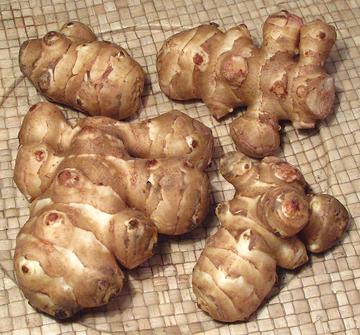 [Sunchoke, Sunroot; Topinambour (French); Helianthus
tuberosus | Helianthus maximiliani
Maximilian sunflower]
[Sunchoke, Sunroot; Topinambour (French); Helianthus
tuberosus | Helianthus maximiliani
Maximilian sunflower]
"Sunchokes", as they are now most frequently marketed, are the root tubers of a variety of sunflower. This plant is aggressively productive but the tubers have been prevented from becoming a major food crop by having a more distinctive flavor than potatoes, and being 75% inulin rather than starch (of which they have none). This can produce flatulence and gastric distress in persons not accustomed to consuming inulin. Others consider inulin an important health food. They also have a graying problem after cooking due to high iron content. Both these problems are treated below
H. tuberosus was used similarly to the Jerusalem Artichoke by the Plains Indians, but it is no longer in use, the Plains Indians having been driven from the land.
The name "Jerusalem Artichoke" has been debated for some time. The "Artichoke" part of the name comes from the cooked root supposedly tasting much like artichoke heart. This was reported by by explorer Samuel de Champlain in the very early 1600s, and it stuck. The Jerusalem part is most often blamed on an English corruption of the Italian word girasole, as the English are wont to do with foreign words. Problem: the Italians apparently didn't apply the term girasole to the sunflower until about 100 years after the English were calling this root tuber "Jerusalem Artichoke".
The most probable explanation is an English corruption of the name of a Dutch town, Terneuzen, from where the tubers were probably first exported to England. The English name appears about 4 years after start of significant production by the Dutch, who were exporting a lot of produce to England at the time.
The French name, Topinambour, used also in other European countries, was a marketing ploy. Some Indians of the tribe called Topenambaux, from Brazil were visiting Europe and getting a lot of publicity about the time these root tubers arrived in France in quantity. Hawkers exploited the publicity, and for about 300 years the French presumed these came from South America, not Canada.
More on Daisy Family - Roots, Seeds
& Oil
Interestingly, as with beans, most people can build up tolerance to inulin if they eat enough of it, their gut flora adjusts to the inulin and breaks it down before it gets to the large intestine. The same can be seen with people who eat a lot of beans, the flatulence problem is greatly reduced.
Other methods are aging under refrigeration for months, steaming in a 200°F/93°C oven for 24 hours (the American Indians used pit steaming overnight). These treatments result in a sweeter tuber because they break a lot of the inulin down into digestible fructose.
Sunchokes can also be deep fried, similarly to potato chips and French fries.
The problem with them graying after cooking is much easier to solve than the inulin problem. If you want tender slices, add Citric Acid (1/4 t per quart of water) or Lemon Juice (1 Tablespoon per quart of water) for the last 5 minutes of boiling. If you want crisper slices, add the Citric Acid or Lemon Juice to the water before adding the tuber slices. Howard McGee used Cream of Tarter (1/4 t per quart) but that isn't so commonly found in kitchens around here.
dy_jeruz 140706 - www.clovegarden.com